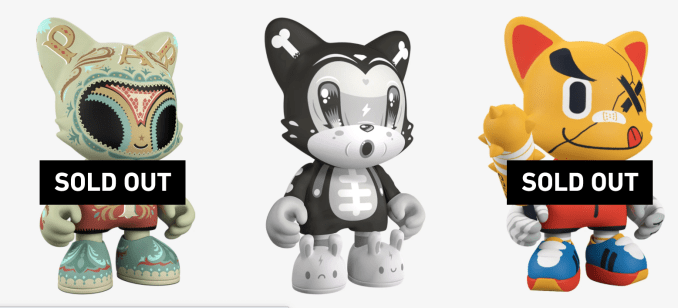A company from the creator of Ello and Kidrobot is announcing a new $20 million funding round to build out an imagined virtual world populated with deranged-yet-cute cartoon influencers.
Superplastic‘s investors include Google Ventures, Index Ventures, Founders Fund, Craft Ventures, Galaxy Digital, Mantis VC/The Chainsmokers, Kakao, LINE Friends and individual investors like Cyan Bannister, Jared Leto, Justin Timberlake and Scooter Braun, among others. The $20 million Series A round brings the company’s total capital raised to $38 million.
Superplastic’s proposition is a strange one. The company owns an animated collab house of “synthetic superstars” — characters who live on social media and pop up everywhere else through partnerships with celebrities, iconic fashion brands and gaming platforms. The company has already racked up millions of followers across Instagram and TikTok, sold millions in NFTs and built up a bustling Discord community, all around a stable of violent, fashion-forward cartoon characters.
“Everything is driven by the characters and the story… and in a way Superplastic [is] the management team,” Superplastic founder Paul Budnitz told TechCrunch.
Budnitz is aiming high, aspiring to build his own “fucked up Disney.” Guggimon, one of Superplastic’s central characters, intermittently tortures his counterpart and models virtual Gucci gear — just one of Superplastic’s many lucrative partnerships. Guggimon also popped up in one of Fortnite’s recent seasons, not just as a skin but as a full-blown featured character, appearing next to Superman. Meanwhile, Superplastic’s relationship with LINE and Kakao is already helping the characters gain a foothold in Asian markets that Kidrobot never quite pulled off.
Superplastic is also deep into the NFT phenomenon, which makes sense given Budnitz’s experience shaping the world of IRL collectibles with KidRobot. But he wasn’t always a believer. Budnitz told TechCrunch that he dismissed the phenomenon at first. “With the NFT thing, I was like nah, this shit is stupid. Suddenly I totally fucking got it all at once.” (Budnitz also initially felt the same way about Bitcoin before meeting a mysterious crypto evangelist with “really long fingernails” at an event who talked him into investing.)
Earlier this year, Superplastic partnered with Christie’s for an NFT drop through the storied auction house, complete with its own fittingly chaotic fictional narrative about two of the characters blowing up the building in the process.

Image Credits: Superplastic
Superplastic dipped its toes into the wild world of digital collectibles starting in February, and now it’s running a full-blown Discord-based community known as the Jankyverse where members show off both the physical and digital figurines they’ve copped. Unlike most of the dime-a-dozen NFT projects churning out digital avatars, Superplastic developed its characters and fictional universe up front rather than tacking it on (or promising to tack it on) after cashing in on the speculative craze driving astronomical prices on OpenSea.
Superplastic is doing the NFT thing, but that’s just one channel in what’s ultimately a platform-agnostic vision. The company is all about expanding its universe of fictional chaos across mediums and it’s already cashing in on toy sales, apparel, NFTs and licensing, like collaborations with Epic Games, virtual persona pioneer Gorillaz and Gucci.
The characters might be also all over the place, but Budnitz is very clear that his company won’t sell bits of the IP off — even in exchange for a major partnership. The company said no to Quibi before that company’s untimely demise last year and also turned down two streaming studios that wanted to own a piece of Superplastic’s characters in perpetuity.
With the new investment, Superplastic will run with its plans for an animated feature film slated for 2022 starring its disturbed cast of alt-Disney characters. The company also plans to open retail shops in New York and Miami early next year to tie its digital collectibles to exclusive IRL experiences like secret areas just for NFT holders in-store.
“I’m more interested in connecting the real world, not just doing stuff that’s all virtual,” Budnitz said.
